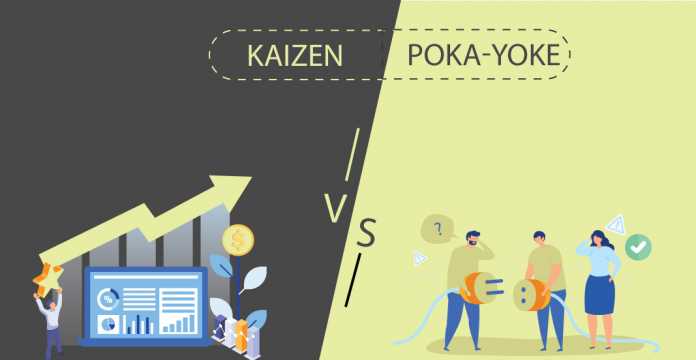
Kaizen and Poka Yoke, both originated from the Toyota Production System (TPS). But, you might be wondering how are they different from each other. In this article, let us explore the difference between Kaizen and Poka Yoke.
What Does Kaizen Mean?
Kaizen is a Japanese word that translates to improving the bad points or making them better. Changing for the better is the Kaizen philosophy, which cannot be accomplished without continuous improvement. It is a change in mindset which helps people understand and realize their true potential and improve themselves.
The Kaizen principle originated in Toyota and is implemented all around the world. It is still a widely used method in the company because it guarantees improvement in products and delivery, especially in the manufacturing industry. Using Kaizen, Toyota has managed to create effective systems in their management processes so that they can generate improvements continuously and review them. The systems technique used at Toyota for their production is known as the Toyota Production System (TPS), and one of the most important principles in TPS is Kaizen.
More and more companies are implementing Kaizen as a part of their Lean thinking in their operations. It safeguards them against the dynamic, continuously evolving, and unsafe business environment.
What Does Kaizen Mean for Companies?
The Kaizen culture is considered to be a way of life that helps companies and employees improve their processes and themselves. Kaizen uses the principle of knowledge sharing and transfer between all the team members to help the entire team develop and grow. Team and business leaders who practice Kaizen are encouraged to help their employees reach their full potential.
Benefits of Kaizen
After implementing the Kaizen mindset in organizations, they have noticed its many benefits. Some of the advantages of establishing a Kaizen culture in companies are:
- The entire company works in the same way and speaks the same language. Kaizen standardizes specific processes and focuses on making small continual changes. All employees are a part of this right from the beginning, which helps them improve their work culture and mindset along with improvement in their processes.
- Since the Kaizen culture is focused on creating continuous improvements, the entire organization builds a mindset that is centered around growth. This is an important factor in any company’s success because the entire organization becomes united and has the same mindset toward development.
- Continuous improvements mean continuous results, and this acts as a motivating factor for all employees. They can see that their actions result in positive change within the company, and they become highly motivated to contribute.
- All new ideas to help improve the existing workflow and processes become more welcome once the organization has adopted Kaizen into their company. Change is considered to be a positive force, which creates an environment where new ideas and opportunities are appreciated.
- Once companies start following the continuous improvement model for all their work, they minimize waste, which saves the organization time and resources, which they can then spend on improving and accelerating their business.
What are Kaizen Events?
A Kaizen plan is made with many steps that help with improving existing processes. A usual Kaizen event steps are listed below:
- Set goals for the team or project along with all information necessary
- Review the existing processes and create an improvement plan and strategy
- Implement the improvements discussed in the previous step
- Review those improvements and check for what does not work, and then fix the issues
- After all improvements and drawbacks have been managed and fixed, report the results and see if there is any follow-up required
This Kaizen event is known as the PDCA – Plan, Do, Check, and Act – method, which takes a scientific approach to continuous improvements.
- ‘Plan’ is concerned with creating a hypothesis
- ‘Do’ is concerned with running experiments to test the hypothesis
- ‘Check’ is concerned with evaluating the results of the experiments
- ‘Act’ is the act of refining the experiment before starting another cycle
What Does Poka Yoke Mean?
Poka Yoke is another term that was born in Japan at Toyota. It was coined in the 1960s by Shigeo Shingo, who was employed as an industrial engineer there. He was also responsible for creating and streamlining Zero Quality Control. Zero Quality Control is a way of correcting and preventing any possible defects in production using a combination of Poka Yoke techniques.
Poka Yoke stands for mistake-proofing, which was considered a big improvement over the original term, Baka-yoke, which meant fool-proofing. This term was considered to be offensive to the employees at Toyota and had to be changed.
The Poka-Yoke techniques were created to ensure that there are perfect conditions in place before any new step or process gets executed to prevent any defects from taking place. It is also a part of the Lean methodology, and its main focus is to avoid any mistakes. In case a mistake or defect cannot be prevented from occurring, Poka Yoke can also be used to detect any defects and eliminate them as soon as possible.
So the Poka Yoke techniques have the following function when it comes to any defects or human errors:
- Prevention
- Correction
- Draw attention
Benefits of Poka Yoke
By eliminating any errors or defects at the beginning itself, Poka Yoke helps improve the overall quality of any process in an organization. Some of the benefits of Poka Yoke are as follows:
- Improve the quality of products significantly by removing all defects
- Work alongside the continuous improvement culture created by Lean methods and aid its processes
- Fine-tune all existing improvement processes and their designs in Six Sigma that use the DMAIC method for their projects by eliminating human and mechanical errors in both
- Use the flexibility of Poka Yoke to make it a cost-effective approach to production and manufacturing
How to Use Poka Yoke?
Any possible places that could have mistakes could use Poka Yoke techniques, which are practically everywhere in an organization. The techniques can be used in manufacturing as well as services to prevent errors because they can be applied to any process. Some of the errors Poka Yoke can be used to prevent are as follows:
- Errors in processing
- Errors with the setup
- Any missing parts in assembly or welding in manufacturing
- Any wrong parts used in manufacturing
- Operational errors
- Errors with measurements
Poka Yoke provides universally applicable techniques that can be used by implementing the following steps:
- Identify the operation or process that Poka Yoke techniques need to be applied to
- Analyze the ways in which the process or operation can fail
- Select the right approach or Poka Yoke technique such as the shutout technique or the attention technique
- Use the selected approach comprehensively
- Determine what method is appropriate (contact method, which uses the physical attributes to detect errors, constant number method, which uses the lack of actions and their numbers for errors, or the sequencing method, which is a checklist to make sure all the steps in the process are complete)
- Test the selected method from above and check if it is working
- Train the operator in this method
- Review the performance of the selected method
- Measure the success of the method
Final Thoughts
So, now you know what is the difference between Kaizen and Poka Yoke. Both of them are techniques and methods that fall under the Lean Methodology. Understanding them, improving the organization’s knowledge and expertise through certifications, and implementing them successfully are crucial in creating a waste-free and continuously improving organization.
Some of the popular quality management certification courses that individuals and enterprise teams can take up are:














